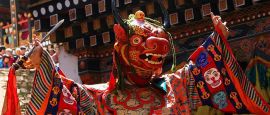In Bhutan, archery (dha) is more than just a sport—it is a passionate national obsession woven into the country's cultural fabric. Unlike Olympic archery, where silence and precision rule, Bhutanese archery tournaments are lively spectacles filled with singing, dancing, and friendly taunts exchanged between teams. Matches can last for days, especially during festivals. To witness a Bhutanese archery match is to see sportsmanship, tradition, and sheer joy collide in a uniquely Bhutanese way.
Bhutan things to see and do
Tucked away in eastern Bhutan, Bumdeling Wildlife Sanctuary is a remote and pristine refuge teeming with biodiversity. Spanning dense forests, alpine meadows, and winding river valleys, it is home to rare species such as the red panda, Himalayan black bear, and over 100 species of butterflies. The sanctuary also serves as a wintering ground for the endangered black-necked cranes, which migrate here from Tibet, making it a paradise for birdwatchers.
Bumthang is a region of four interconnected valleys—Chokhor, Tang, Ura, and Chhume—each steeped in legends, ancient monasteries, and timeless rural beauty. This is Bhutan's spiritual heartland, home to revered temples, including Jambay Lhakhang, where the famous fire dance festival takes place, and Kurjey Lhakhang, a sacred site said to bear the imprint of Guru Rinpoche. Most visitors base themselves in Jakar, the largest town, before setting off to explore the Chokhor Valley, where chapels, chortens, and picturesque villages sit against a backdrop of rolling hills and blue pine forests.
For those craving a Himalayan panorama, Dochula Pass is the place to be. Sitting at 3,100m (10,171 ft), this mountain pass is studded with 108 memorial chortens (stupas) and offers a jaw-dropping vista of snow-capped peaks on a clear day. The crisp mountain air, the scent of pine, and the sight of prayer flags dancing in the wind make this a truly meditative stop on the way to Punakha.
In the serene village of Drametse in eastern Bhutan, a profound spiritual tradition comes alive through the Drametse Ngacham, or the "Mask Dance of the Drums". This sacred performance, believed to have originated in the 16th century, features dancers donning intricately crafted masks and vibrant costumes, moving rhythmically to the deep, resonant beats of traditional drums. Recognised by UNESCO as a Masterpiece of the Oral and Intangible Heritage of Humanity, witnessing this dance offers a profound glimpse into Bhutan's rich spiritual tapestry.
Set against a backdrop of emerald rice fields and fluttering prayer flags, Paro is the soul of Bhutanese spirituality. It is home to the country's most iconic sight, Tiger's Nest Monastery (Paro Taktsang), a gravity-defying sanctuary clinging to a sheer cliff face. The Paro Dzong, with its towering whitewashed walls and intricate woodwork, is another must-visit, offering sweeping views of the valley. As the sun sets, the riverbanks fill with locals in traditional dress, enjoying the crisp mountain air.
Remote, untouched, and breathtakingly beautiful, Phobjikha is a glacial valley in central Bhutan where nature reigns supreme. It is best known as the winter home of the endangered black-necked cranes, which migrate here from Tibet every year. Locals celebrate their arrival with the Black-Necked Crane Festival, a heartwarming event filled with traditional dances and conservation efforts. Even without the cranes, the valley is a dreamlike landscape of rolling meadows, quaint villages, and a timeless stillness that lingers long after you leave.
At the centre of Punakha lies the magnificent Punakha Dzong, arguably the most beautiful fortress in Bhutan, set at the confluence of two rivers. This dzong isn't just a visual delight—it also holds deep historical significance as the site of Bhutan's royal coronation. Adventure seekers can take to the waters with white-water rafting on the Pho Chhu and Mo Chhu rivers, while those seeking tranquillity can visit the picturesque Khamsum Yulley Namgyal Chorten, a hilltop temple with panoramic valley views.
Bhutan's capital, Thimphu, has no traffic lights—just white-gloved policemen gracefully directing the flow of cars. The city is home to the towering Buddha Dordenma, a 51-metre golden statue that gazes serenely over the valley. Meanwhile, the bustling Centenary Farmers' Market offers a kaleidoscope of local flavours, from dried yak cheese to fiery red chillies.
Tiger's Nest Monastery (Paro Taktsang) is probably Bhutan's most iconic landmark. Perched dramatically on a cliffside, 3,120m (10,236 ft) above sea level, this sacred site is both a pilgrimage and an adventure. The two-hour uphill trek is rewarded with jaw-dropping views and a serene atmosphere that feels like time has paused. Legend has it that Guru Rinpoche flew here on the back of a tigress in the 8th century, bringing Buddhism to Bhutan. To witness it in person is to understand why Bhutan is often described as the last Shangri-La.
Trashiyangtse is a picturesque town in eastern Bhutan, nestled amidst lush greenery and rolling hills. Two prominent landmarks are the 18th-century Chorten Kora and the School of 13 Traditional Arts (Rigney School). The latter preserves Bhutan's artistic heritage through disciplines such as painting, woodwork, and embroidery.
For those seeking adventure intertwined with spiritual discovery, Bhutan's trekking routes offer unparalleled experiences. Trails such as the Druk Path Trek (5 to 6 days) and the challenging Snowman Trek (25 to 27 days) meander through pristine forests, alpine meadows, and remote villages, all set against the majestic backdrop of the Himalayas.
Do you have any Feedback about this page?
© 2025 Columbus Travel Media Ltd. All rights reserved. No part of this site may be reproduced without our written permission, click here for information on Columbus Content Solutions.








 You know where
You know where